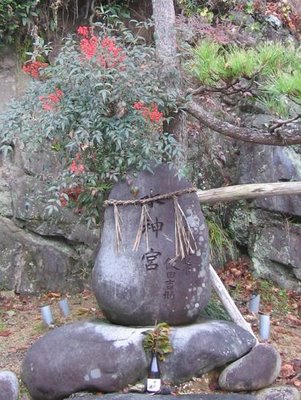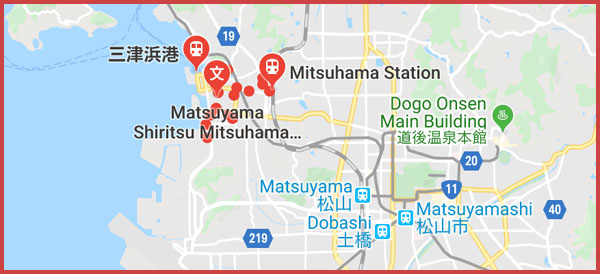https://edoflourishing.blogspot.com/2019/09/tokugawa-michi-road.html
[ . BACK to DARUMA MUSEUM TOP . ]
. Kaido 街道 Highways - ABC Index .
::::::::::::::::::::::::::::::::::::::::::::::::::::::::::::::::::::::::::::::::::::::::::::::::::::::::::::::::::::::::::::::::::::::::::::::::::::::::::::::::::::::::::::::::::::
Tokugawa michi 徳川道 Road for Tokugawa
This road is a branch road of the
. Sanyo Kaido 山陽街道 Sanyo Highway and 西国街道 Saigoku Kaido .

To avoid accidents with foreigners coming from Kobe Harbour on their way to Edo during
he Bakumatsu 幕末 final years of the Edo period.
The harbour of 神戸市 Kobe city was opened to foreigners in 1867.
- - Starting station : Branching off from the 西国街道 Saigoku Kaido
present day 灘区御影石町 Kobe, Nada ward, Mikage-Ishimachi
石屋川 - River Ishiyagawa
阪急六甲駅南 - South of the Rokko Station (Rokkosan 六甲山 Mount Rokko)
八幡町 - Yahata
神戸護国神社 - Gokoku Shrine, Kobe
杣谷登山口 - Somadani - along the valley Somadanizoi (杣谷沿い)
杣谷峠 Somadani toge pass
摩耶山北斜面 Northern slope of 摩耶山 Mount Maya san
桜谷分岐 Sakuradani branch divide
生田川沿い - along the river Ikutagawa
森林植物園東門 - East entrance of the Kobe Municipal Arboretum
弘陵学園高校正門前 - Main entrance of the Kobe Koryo Gakuen High School
北区山田町小部 - Obu hamlet, Yamada town, Kita ward, Kobe
鈴蘭台 - Suzurandai
白川 - Shirakawa
高塚山 - Takatsukayama
- - Final station : Branching back to the Saigoku Kaido
present day 明石市大蔵谷 Hyogo, Akashi city, Okuradani

under construction
::::::::::::::::::::::::::::::::::::::::::::::::::::::::::::::::::::::::::::::::::::::::::::::::::::::::::::::::::::::::::::::::::::::::::::::::::::::::::::::::::::::::::::::::::::
. Legends and Tales from Japan 伝説 - Introduction .
................................................................................. Hyogo 兵庫県
神戸市 Kobe city / 摩耶山 Mayasan / 杣谷 Somadani
. kitsune densetsu 狐と伝説 fox legends .
At the pond near the graveyard in the valley Somadani at the food of mount Mayasan there lived a fox called 兵五郎 Heigoro. Once a man visiting a grave peeked into the hole where the fox lived. He head the animal growling and the man became very dizzy. He hardly found his way home.
- - - - -

source : city.kobe ...
. Temple 仏母麻耶山忉利天上寺 Butsumo Maya San Toriten Jo-Ji .
Near the top of Mount Rokko in Ashiya, Kobe
Maya mode 摩耶詣 pilgrimage to the Maya temple
chi no ike jigoku 血の池地獄 blood-red pond of hell
A special purification ritual before the pilgrimage was performed at the 不動の瀧 Fudo Waterfall near the bridge 観音橋 Kannon-bashi over a small river.
If a woman had died during giving birth, she will fall into the blood pond of hell. Her relatives make small scoops out of white cloth and scoop the water of the river. If the cloth will get holes soon, the dead woman will soon be able to go to Paradise.
..............................................................................................................................................
六甲山 Mount Rokkosan

source : yamahack.com...
- quote -
Mount Rokko is close to the cities of Osaka and Kobe and to the hot springs of Arima Onsen.
From the top of Mt. Rokko one has a panoramic view of Osaka Bay or the wonderful night view over the city of Kobe.
In every season Mt. Rokko offers a spectacle of nature, along with places for dining and shopping.
- source : rokkosan.com... -
.......................................................................
. Ebisu えびす / 恵比寿と伝説 Legends about Ebisu .
Ebisu at Mount 六甲 Mount Rokkosan, Shrine Nishinomiya 西宮.
- - - - -
Hidarugami ひだる神 the Hunger God / Hidarubo ひだるぼう
If someone walks along Mount Rokkosan, the gaki 餓鬼 hunger gods bewitched him, his hands begun to tremble and he had to sit down.
In winter, even if there is snow, he begins to drip sweat from his hands and can not go on further.
If he gets a raw egg to eat, he will soon come back to his senses.
One can also just drop one grain of raw or cooked rice and say "Ahh, this was delicious" to be healed.
.....
In the back of the temple 鷲林寺 Jurin-Ji near Nishinomiya there is the pass Kuragari toge 暗峠 (小暗峠). At the top is a small place to rest, but if a person drinks from the water flowing down the valley, he will get bewitched by Hidarugami and can not walk any more. Eating a bento 弁当 lunch will heal him.
Once upon a time, when 武田信玄 Takeda Shingen had been defeated by 信長 Oda Nobunaga, he was hiding here, but since he had no food, he died of hunger. His spirit became ひだるぼう Hidarubo
.....
A zatoo 座頭 Zato, blind minstrel was on his way to a cure at 有馬 Arima Hot Spring, but he died on the way.
If anyone passes this valley, 座頭谷 Zatodani, he will be bewitched by Hidarubo.

座頭谷 Zatodani valley
. Hidarugami ヒダル神 / ひだる神 / ヒダルカミ .
- Hidarubo ひだるぼう
. gaki 餓鬼 hunger ghosts .
The Hungry Ghosts are part of the Six Realms of Existence, rokudoo 六道 of the Buddhist religion.
. zatoo 座頭 Zato, blind minstrel .
- - - - -
shoojiwan ショージワン Shoji bowl
At 六甲山 Mount Rokkosan there is an old pond in the form of a gourd.
The villagers from 上唐櫃の村 Kami-Arato say:
If one goes to the edge of the pond, there will be bowls coming afloat.
When they built a new pond for the village, the same thing happened.
..............................................................................................................................................
- reference : nichibun yokai database -
::::::::::::::::::::::::::::::::::::::::::::::::::::::::::::::::::::::::::::::::::::::::::::::::::::::::::::::::::::::::::::::::::::::::::::::::::::::::::::::::::::::::::::::::::::

- - - To join me on facebook, click the image !
:::::::::::::::::::::::::::::::::::::::::::::::::::::::::::::::::::::::::::::::::::::::::::::::::::::::::::::::::::::::::::::::::::::::::::::::::::::::::::::::::::::::::::::::::::::
. kaidoo 街道と伝説 Legends about the old Kaido highways .
. Kaido 街道 Highways - ABC Index .
. Famous Places and Powerspots of Edo 江戸の名所 .
. Edo bakufu 江戸幕府 The Edo Government .
. Doing Business in Edo - 商売 - Introduction .
. shokunin 職人 craftsman, craftsmen, artisan, Handwerker .
. senryu, senryū 川柳 Senryu poems in Edo .
. Japanese Architecture - The Japanese Home .
. Interior Design - The Japanese Home .
. Legends and Tales from Japan 伝説 - Introduction .
[ . BACK to DARUMA MUSEUM TOP . ]
[ . BACK to WORLDKIGO . TOP . ]
- - - - - #tokugawamichi #tokugawa #sanyodo - - - -
::::::::::::::::::::::::::::::::::::::::::::::::::::::::::::::::::::::::::::::::::::::::::::::::::::::::::::::::::::::::::::::::::::::::::::::::::::::::::::::::::::::::::::::::::::
Tokugawa michi road
. Kaido 街道 Highways - ABC Index .
::::::::::::::::::::::::::::::::::::::::::::::::::::::::::::::::::::::::::::::::::::::::::::::::::::::::::::::::::::::::::::::::::::::::::::::::::::::::::::::::::::::::::::::::::::
Tokugawa michi 徳川道 Road for Tokugawa
This road is a branch road of the
. Sanyo Kaido 山陽街道 Sanyo Highway and 西国街道 Saigoku Kaido .

To avoid accidents with foreigners coming from Kobe Harbour on their way to Edo during
he Bakumatsu 幕末 final years of the Edo period.
The harbour of 神戸市 Kobe city was opened to foreigners in 1867.
- - Starting station : Branching off from the 西国街道 Saigoku Kaido
present day 灘区御影石町 Kobe, Nada ward, Mikage-Ishimachi
石屋川 - River Ishiyagawa
阪急六甲駅南 - South of the Rokko Station (Rokkosan 六甲山 Mount Rokko)
八幡町 - Yahata
神戸護国神社 - Gokoku Shrine, Kobe
杣谷登山口 - Somadani - along the valley Somadanizoi (杣谷沿い)
杣谷峠 Somadani toge pass
摩耶山北斜面 Northern slope of 摩耶山 Mount Maya san
桜谷分岐 Sakuradani branch divide
生田川沿い - along the river Ikutagawa
森林植物園東門 - East entrance of the Kobe Municipal Arboretum
弘陵学園高校正門前 - Main entrance of the Kobe Koryo Gakuen High School
北区山田町小部 - Obu hamlet, Yamada town, Kita ward, Kobe
鈴蘭台 - Suzurandai
白川 - Shirakawa
高塚山 - Takatsukayama
- - Final station : Branching back to the Saigoku Kaido
present day 明石市大蔵谷 Hyogo, Akashi city, Okuradani

under construction
::::::::::::::::::::::::::::::::::::::::::::::::::::::::::::::::::::::::::::::::::::::::::::::::::::::::::::::::::::::::::::::::::::::::::::::::::::::::::::::::::::::::::::::::::::
. Legends and Tales from Japan 伝説 - Introduction .
................................................................................. Hyogo 兵庫県
神戸市 Kobe city / 摩耶山 Mayasan / 杣谷 Somadani
. kitsune densetsu 狐と伝説 fox legends .
At the pond near the graveyard in the valley Somadani at the food of mount Mayasan there lived a fox called 兵五郎 Heigoro. Once a man visiting a grave peeked into the hole where the fox lived. He head the animal growling and the man became very dizzy. He hardly found his way home.
- - - - -

source : city.kobe ...
. Temple 仏母麻耶山忉利天上寺 Butsumo Maya San Toriten Jo-Ji .
Near the top of Mount Rokko in Ashiya, Kobe
Maya mode 摩耶詣 pilgrimage to the Maya temple
chi no ike jigoku 血の池地獄 blood-red pond of hell
A special purification ritual before the pilgrimage was performed at the 不動の瀧 Fudo Waterfall near the bridge 観音橋 Kannon-bashi over a small river.
If a woman had died during giving birth, she will fall into the blood pond of hell. Her relatives make small scoops out of white cloth and scoop the water of the river. If the cloth will get holes soon, the dead woman will soon be able to go to Paradise.
..............................................................................................................................................
六甲山 Mount Rokkosan

source : yamahack.com...
- quote -
Mount Rokko is close to the cities of Osaka and Kobe and to the hot springs of Arima Onsen.
From the top of Mt. Rokko one has a panoramic view of Osaka Bay or the wonderful night view over the city of Kobe.
In every season Mt. Rokko offers a spectacle of nature, along with places for dining and shopping.
- source : rokkosan.com... -
.......................................................................
. Ebisu えびす / 恵比寿と伝説 Legends about Ebisu .
Ebisu at Mount 六甲 Mount Rokkosan, Shrine Nishinomiya 西宮.
- - - - -
Hidarugami ひだる神 the Hunger God / Hidarubo ひだるぼう
If someone walks along Mount Rokkosan, the gaki 餓鬼 hunger gods bewitched him, his hands begun to tremble and he had to sit down.
In winter, even if there is snow, he begins to drip sweat from his hands and can not go on further.
If he gets a raw egg to eat, he will soon come back to his senses.
One can also just drop one grain of raw or cooked rice and say "Ahh, this was delicious" to be healed.
.....
In the back of the temple 鷲林寺 Jurin-Ji near Nishinomiya there is the pass Kuragari toge 暗峠 (小暗峠). At the top is a small place to rest, but if a person drinks from the water flowing down the valley, he will get bewitched by Hidarugami and can not walk any more. Eating a bento 弁当 lunch will heal him.
Once upon a time, when 武田信玄 Takeda Shingen had been defeated by 信長 Oda Nobunaga, he was hiding here, but since he had no food, he died of hunger. His spirit became ひだるぼう Hidarubo
.....
A zatoo 座頭 Zato, blind minstrel was on his way to a cure at 有馬 Arima Hot Spring, but he died on the way.
If anyone passes this valley, 座頭谷 Zatodani, he will be bewitched by Hidarubo.

座頭谷 Zatodani valley
. Hidarugami ヒダル神 / ひだる神 / ヒダルカミ .
- Hidarubo ひだるぼう
. gaki 餓鬼 hunger ghosts .
The Hungry Ghosts are part of the Six Realms of Existence, rokudoo 六道 of the Buddhist religion.
. zatoo 座頭 Zato, blind minstrel .
- - - - -
shoojiwan ショージワン Shoji bowl
At 六甲山 Mount Rokkosan there is an old pond in the form of a gourd.
The villagers from 上唐櫃の村 Kami-Arato say:
If one goes to the edge of the pond, there will be bowls coming afloat.
When they built a new pond for the village, the same thing happened.
..............................................................................................................................................
- reference : nichibun yokai database -
::::::::::::::::::::::::::::::::::::::::::::::::::::::::::::::::::::::::::::::::::::::::::::::::::::::::::::::::::::::::::::::::::::::::::::::::::::::::::::::::::::::::::::::::::::

- - - To join me on facebook, click the image !
:::::::::::::::::::::::::::::::::::::::::::::::::::::::::::::::::::::::::::::::::::::::::::::::::::::::::::::::::::::::::::::::::::::::::::::::::::::::::::::::::::::::::::::::::::::
. kaidoo 街道と伝説 Legends about the old Kaido highways .
. Kaido 街道 Highways - ABC Index .
. Famous Places and Powerspots of Edo 江戸の名所 .
. Edo bakufu 江戸幕府 The Edo Government .
. Doing Business in Edo - 商売 - Introduction .
. shokunin 職人 craftsman, craftsmen, artisan, Handwerker .
. senryu, senryū 川柳 Senryu poems in Edo .
. Japanese Architecture - The Japanese Home .
. Interior Design - The Japanese Home .
. Legends and Tales from Japan 伝説 - Introduction .
[ . BACK to DARUMA MUSEUM TOP . ]
[ . BACK to WORLDKIGO . TOP . ]
- - - - - #tokugawamichi #tokugawa #sanyodo - - - -
::::::::::::::::::::::::::::::::::::::::::::::::::::::::::::::::::::::::::::::::::::::::::::::::::::::::::::::::::::::::::::::::::::::::::::::::::::::::::::::::::::::::::::::::::::


























